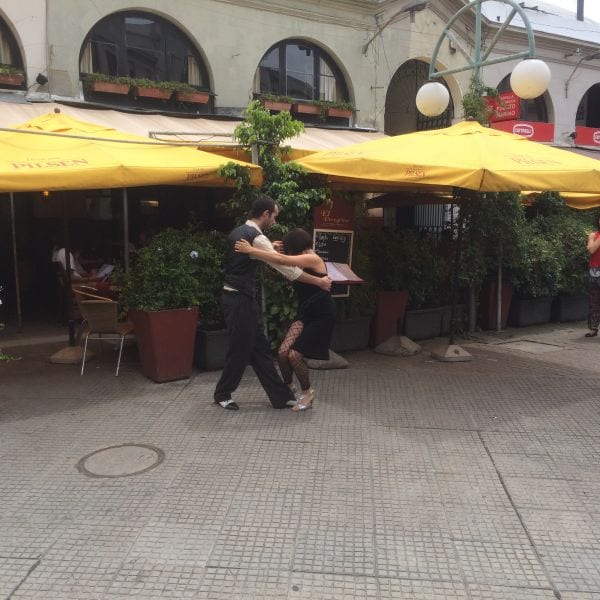Tango began in the early 1900’s in Buenos Aires and Montevideo.
Beginning in brothels, like American jazz, it was refined and adopted by middle and upper classes, cleaned up and turned into a respectable music and dance form.
Dance competitions usually contain the tango, a sensual dance with complicated movements and hypnotic music.
In front of one of the cafes near my studio, there is a demonstration of tango with a lady who is much older than her partner. She is dressed in black with net stockings and clipped black hair. The couple move over rough tiles as music plays loudly from a little black speaker.The traditional tango is played by an orchestra that has a piano, two accordions, two violins and a double bass. This recorded music is just violins.
For an entire song, we in the audience watch the pair move in ever widening, and then contracting, circles in front of the restaurant. She makes most of the movements, dipping her shoulder, lifting her knees, tossing back her head, letting the young man lead.
The themes of Tango are unrequited love, betrayal, the passage of time, and death.
A famous local poet, Enrique Discepolo, called tango “the sad thought that is danced.”
Tango came from poor neighborhoods in Buenos Aires and Montevideo where money runs short and emotions run high.
Cutting edge art flows from those who live closest to their emotions and have empty wallets.
Search The Site
Translate This Page
Support Scott
See Scott’s Artwork!
Your purchase helps Scott continue his travels and he’ll reciprocate by taking you along in words, photos and videos!Recent Posts
Recent Comments
- scott on Fishing/Palo Duro Canyon
- rhett ladd on Fishing/Palo Duro Canyon
- scott on Strawberry Shortcake
- Charlie on Strawberry Shortcake
- scott on Prepper Money
- Alan on Prepper Money
- scott on Decorative Art
Archives
- April 2020 (28)
- November 2019 (1)
- October 2019 (5)
- September 2019 (3)
- August 2019 (8)
- July 2019 (18)
- June 2019 (8)
- May 2019 (21)
- March 2019 (52)
- February 2019 (22)
- November 2018 (18)
- October 2018 (9)
- August 2018 (1)
- July 2018 (10)
- June 2018 (11)
- December 2017 (11)
- August 2017 (12)
- June 2017 (18)
- April 2017 (10)
- March 2017 (33)
- February 2017 (33)
- January 2017 (2)
- October 2016 (2)
- September 2016 (49)
- June 2016 (1)
- March 2016 (2)
- February 2016 (8)
- January 2016 (16)
- December 2015 (50)
- November 2015 (57)
- October 2015 (7)
- September 2015 (10)
- August 2015 (11)
- July 2015 (5)
- June 2015 (6)
- May 2015 (8)
- April 2015 (6)
- March 2015 (8)
- January 2015 (29)
- December 2014 (30)
- November 2014 (83)
- October 2014 (3)
Categories
- Country (423)
- Belize (57)
- Costa Rica (10)
- Dominican Republic (55)
- Ecuador (56)
- Haiti (18)
- Mexico (48)
- Nicaragua (51)
- Philippines (30)
- Uruguay (98)
- Photo Shoots (10)
- Scott's Best Of (713)
- Animal Stories (86)
- Art, Music, Performance, Writing (122)
- Blast to the Past (111)
- Fish Stories (28)
- Friends & Family (88)
- Getting Around (81)
- Holidays, Events & Celebrations (50)
- Home Bases (69)
- Kids (47)
- Money Talk (118)
- Mother Nature Saddles Up (106)
- On the Beach (49)
- People (214)
- Places to Go & Things to See (185)
- Quirky (134)
- Shop 'til You Drop (57)
- Spirit Talks (194)
- Sports & Recreation (75)
- The Great Security State (108)
- What's to Eat (125)
- Working For a Living (154)
- States (293)
- Arizona (48)
- California (6)
- Colorado (36)
- Florida (10)
- Nebraska (6)
- New Mexico (150)
- Texas (37)
- Videos (66)




Wow you’ve been writing up a storm….when do you find the time? Sounds like you can move around town easily using public transportation which should keep costs down. Had any more problems with your hot water heater?